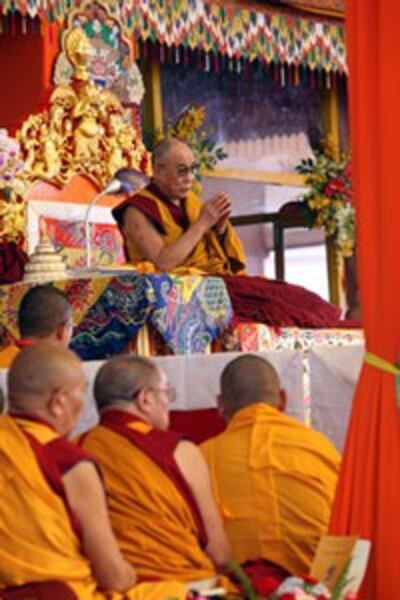Tens of thousands of Buddhist pilgrims from around the world traveled this week to Bodhgaya, a town in northern India, to hear exiled Tibetan spiritual leader the Dalai Lama give the "Kalachakra" religious teachings.
At least 9,000 Tibetans traveling on Chinese passports, along with an estimated 1,200 Chinese Buddhists from the mainland, are among those who have registered with the event authorities.
“We suspect that there are many more from Tibet and China who have not registered with our Kalachakra office,”said a Tibetan exile government official waving his hand over a sea of humanity overflowing from tents onto patches of earth and concrete, trees, and rooftops to hear the Dalai Lama speak.
“There are over 400,000 people here. Just look!,” the official said.
At the start of each teaching, the Dalai Lama ascends a throne under a vast tent as Buddhist masters from East and Southeast Asia recite prayers in Pali, Korean, Japanese, and Chinese. An adjoining tent is filled with computers, microphones, and technicians providing simultaneous translation in 16 languages.
Loudspeakers and video screens disseminate throughout the site the Dalai Lama’s voice and image, together with images of monks and lamas gathered on the stage.
The Dalai Lama is a living symbol of the Buddhist faith, and a Kalachakra blessing—the 32nd he has given in his lifetime—conducted in this pilgrimage town is an event of great significance for Buddhists, especially Tibetans.
Ritual

Kalachakra, which means “Wheel of Time,” is an ancient Buddhist ritual in which devotees are reborn as the lama’s child to obtain rebirth in Shambala, a celestial kingdom that is prophesized to vanquish the forces of evil in a cosmic battle that is said to come within 300 years.
Here in Bodhgaya, in India's Bihar state, a human prayer wheel spins night and day around the Mahabodhi Temple and its holy pipal tree, where in the 6th century BC, Prince Siddhartha is said to have defeated the demon Mara, attained enlightenment and became the Buddha, the “Awakened One.”
“I flew in from Boston with my wife and three children,” says Jamyang, a U.S. citizen for over 20 years.
“All Tibetan exiles are very, very upset about the wave of self-immolations in Tibet, about the future of our country,” he said, referring to the dozen incidents in which Tibetans had set themselves on fire to vent their anger over Chinese rule.
“We’ve made it a priority to come to this Kalachakra, to unite with our brothers and sisters in Tibet, and to affirm our identity, which the Chinese communists want to destroy,” Jamyang said.
“It’s a very hard time for us.”
Visas
After Deng Xiaoping became China's paramount leader in 1978 and launched an era of “Reform and Opening Up,” his regime issued several thousand visas for pilgrims from Tibet who also made the long trip to Bodhgaya.
“I will never forget the Kalachakra given here in 1985,” says Sonam, a Tibetan now living in Australia. “I was going to school in South India, and my parents told me I had to go because my uncle was coming from Tibet.”
“It was very emotional. So many people were crying, because we learned about who had died and who had gone to prison. We thought it was the start of a new era and that things would get better.”
“But the situation in Tibet just keeps getting worse now. That’s why I made the effort to come here again.”
This year the Tibetan Youth Congress and the Tibetan Women’s Association have set up tents, together with free health clinics and medical dispensaries, to assist the devotees coming from Tibet.
Most pilgrims from Tibet are afraid to have their photos taken. Some traveled to India without passports, and some obtained passports on the black market.
One man from Tibet’s northeastern region of Amdo applied for an Indian visa in Nepal with an Italian passport, insisting he was an Italian national, and was eventually given a visa.
Said an Indian official who asked not to be named, “He wanted to go so badly, we just gave up.”
Bodhgaya, like most Buddhist sites in India, was virtually abandoned for centuries after Buddhism was vanquished by invaders from Central Asia who began raids into India in the ninth century A.D. Tibetan refugees, led by the Dalai Lama, have brought India’s Buddhist heritage back to life.
Bodhgaya now has a sleek modern airport with direct flights from Delhi and other cities in India, large hotels, temples, and monasteries belonging to Buddhist communities in Thailand, Japan, China, Sri Lanka, and other countries.
“The 1985 Kalachakra people slept in tents or in monasteries,” said Thupten, a Tibetan businessman based in Kathmandu who travels often to Tibet and India.
“Now, this is a boom town. When I was in Lhasa in June, everyone was talking about going to this Kalachakra. So I booked my room at the Mahayana Hotel, the best in town, six months ago, and I’m glad I did.”
Lodging
On Wednesday night, a group of exhausted Europeans was seen flashing hundred-euro notes around the Mahayana lobby hoping to obtain lodging, but to no avail.
Thousands of pilgrims from Tibet and the Himalayan belt have rented tents in fields, where young actors and musicians stage concerts and theater performances every night, mixing Tibetan classical music and dance with disco and rap.
And everywhere are Indian citizens who have also come to Bodhgaya.
“This is as great a pilgrimage center as any on earth,” said Sunil, a Bengali who recently moved to Bodhgaya with his family to open a guest house which is filled with Western travelers.
“This might be the greatest Buddhist pilgrimage event of the 21st century. As Indians, we feel blessed to have the Dalai Lama here. We look to him for guidance.”
“That’s why I moved here with my family,” said Sunil. “And business is good, too.”
Reported by Maura Moynihan, a freelance correspondent.
